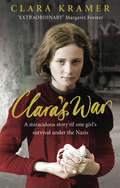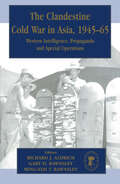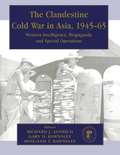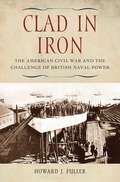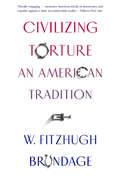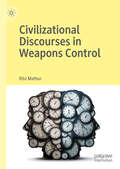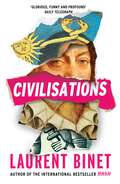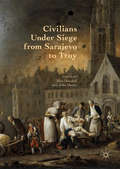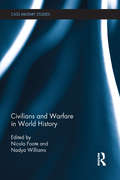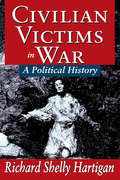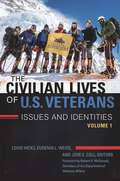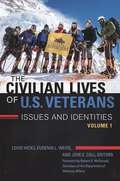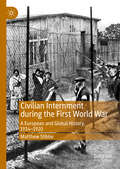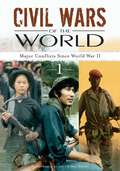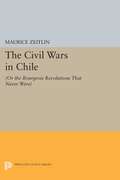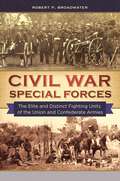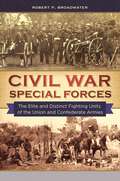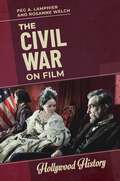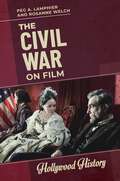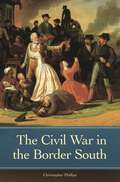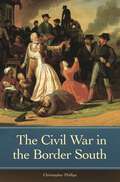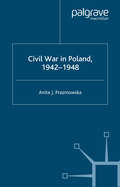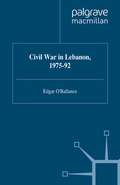- Table View
- List View
Clara's War: A Young Girl's True Story Of Miraculous Survival Under The Nazis
by Clara KramerOn 21 July 1942 the Nazis took control of the small Polish town of Zolkiew, life for Jewish 15-year-old Clara Kramer was never to be the same again. While those around her were either slaughtered or transported, Clara and her family hid perilously in a hand-dug bunker. Living in the house above and protecting them were the Becks.Mr Beck was a womaniser, a drunkard and a self-professed anti-Semite, yet he risked his life throughout the war to keep his charges safe. Nevertheless, life with Mr Beck was far from predictable. From the house catching fire, to Beck's affair with Clara's cousin, to the nightly SS drinking sessions in the room just above, Clara's War transports you into the dark, cramped bunker, and sits you next to the families as they hold their breath time and again.Sixty years later, Clara Kramer has created a memoir that is lyrical, dramatic and heartbreakingly compelling. Despite the worst of circumstances, this is a story full of hope and survival, courage and love.
The Clandestine Cold War in Asia, 1945-65: Western Intelligence, Propaganda and Special Operations
by Richard J. Aldrich Gary D. Rawnsley Ming-Yen T. RawnsleyA range of clandestine Cold War activities in Asia, from intelligence and propaganda to special operations and security support, is examined here. The contributions draw on newly-opened archives and a two-day conference on the subject.
The Clandestine Cold War in Asia, 1945-65: Western Intelligence, Propaganda and Special Operations
by Richard J. Aldrich Ming-Yeh RawnsleyA range of clandestine Cold War activities in Asia, from intelligence and propaganda to special operations and security support, is examined here. The contributions draw on newly-opened archives and a two-day conference on the subject.
Clad in Iron: The American Civil War and the Challenge of British Naval Power
by Howard J. FullerThis work addresses many persistent misconceptions of what the monitors were for, and why they failed in other roles associated with naval operations of the Civil War (such as the repulse at Charleston, April 7, 1863). Monitors were 'ironclads'- not fort-killers. Their ultimate success is to be measured not in terms of spearheading attacks on fortified Southern ports but in the quieter, much more profound, strategic deterrence of Lord Palmerston's ministry in London, and the British Royal Navy's potential intervention.The relatively unknown 'Cold War' of the American Civil War was a nevertheless crucial aspect of the survival, or not, of the United States in the mid 19th-century. Foreign intervention—explicitly in the form of British naval power—represented a far more serious threat to the success of the Union blockade, the safety of Yankee merchant shipping worldwide, and Union combined operations against the South than the Confederate States Navy. Whether or not the North or South would be 'clad in iron' thus depended on the ability of superior Union ironclads to deter the majority of mid-Victorian British leaders, otherwise tempted by their desire to see the American 'experiment' in democratic class-structures and popular government finally fail. Discussions of open European involvement in the Civil War were pointless as long as the coastline of the United States was virtually impregnable. Combining extensive archival research on both sides of the Atlantic, this work offers an in-depth look at how the Union Navy achieved its greatest grand-strategic victory in the American Civil War. Through a combination of high-tech 'machines' armed with 'monster' guns, intensive coastal fortifications and a new fleet of high-speed Union commerce raiders, the North was able to turn the humiliation of the Trent Affair of late 1861 into a sobering challenge to British naval power and imperial defense worldwide.
Civilizing Torture: An American Tradition
by W. Fitzhugh BrundagePulitzer Prize Finalist Silver Gavel Award Finalist “A sobering history of how American communities and institutions have relied on torture in various forms since before the United States was founded.” —Los Angeles Times “That Americans as a people and a nation-state are violent is indisputable. That we are also torturers, domestically and internationally, is not so well established. The myth that we are not torturers will persist, but Civilizing Torture will remain a powerful antidote in confronting it.” —Lawrence Wilkerson, former Chief of Staff to Secretary of State Colin Powell “Remarkable…A searing analysis of America’s past that helps make sense of its bewildering present.” —David Garland, author of Peculiar Institution Most Americans believe that a civilized state does not torture, but that belief has repeatedly been challenged in moments of crisis at home and abroad. From the Indian wars to Vietnam, from police interrogation to the War on Terror, US institutions have proven far more amenable to torture than the nation’s commitment to liberty would suggest. Civilizing Torture traces the history of debates about the efficacy of torture and reveals a recurring struggle to decide what limits to impose on the power of the state. At a time of escalating rhetoric aimed at cleansing the nation of the undeserving and an erosion of limits on military power, the debate over torture remains critical and unresolved.
Civilizational Discourses in Weapons Control
by Ritu MathurThis book seeks to decolonize practices of arms control and disarmament. In this endeavor it seeks to problematize our understanding of time and civilization as rhetorical resources. The need for such an undertaking can be premised on the claim that while problems of modernity, ethnocentrism and universalism are now a central concern within the field of international relations, these ideas are scarcely debated or contested within the field of arms control and disarmament. The singular focus on technological innovations and specific policy-oriented agreements in practices of arms control and disarmament appears to stymie the need for such engagements. This book is an invitation to explore intersecting discourses on colonialism, racialism, nationalism and humanitarianism within a historically grounded terrain of weapons control. An understanding of these practices is vital not to prescribe any standards of civilization or exceptionalism in weapons control but to be cognizant through critique of the dangers embedded in any effort at reconstellating the constitutional nuclear order.
Civilisations
by Laurent BinetA stunningly ambitious and entertaining novel that gives us a counter-factual history of the modern world, from the author of the international bestseller HHhH.'What if the 1492 'discovery' of America...alerted the Incas to the existence of a land to the east that might be ripe for conquest?' Literary Reviewc.1000AD: Erik the Red's daughter heads south from Greenland1492: Columbus does not discover America1531: the Incas invade EuropeFreydis is the leader of a band of Viking warriors who get as far as Panama. Nobody knows what became of them...Five hundred years later, Christopher Columbus is sailing for the Americas, dreaming of gold and conquest. Even when captured by Incas, his faith in his superiority and his mission is unshaken.Thirty years after that, Atahualpa, the last Inca emperor, arrives in Europe. What does he find? The Spanish Inquisition, the Reformation, capitalism, the miracle of the printing press, endless warmongering between the ruling monarchies, and constant threat from the Turks. But most of all, downtrodden populations ready for revolution. Fortunately, he has a recent guidebook to acquiring power - Machiavelli's The Prince. It turns out he is very good at it. So, the stage is set for a Europe ruled by Incas and, when the Aztecs arrive on the scene, for a great war that will change history forever.Civilisations is a wildly entertaining counterfactual story about the modern world, colonisation, empire-building and the eternal human quest for domination. It is an electrifying novel by one of Europe's most exciting writers.***** Daily Telegraph
Civilians Under Siege from Sarajevo to Troy
by John Horne Alex DowdallThis edited volume analyses siege warfare as a discrete type of military engagement, in the face of which civilians are particularly vulnerable. Siege warfare is a form of combat that has usually had devastating effects on civilian populations. From the near-contemporary Siege of Sarajevo to the real and mythical sieges of the ancient Mediterranean, this has been a recurring type of military engagement which, through bombardment, starvation, disease and massacre, places non-combatants at the heart of battle. To date, however, there has been little recognition of the effects of siege warfare on civilians. This edited volume addresses this gap. Using a distinctive regressive method, it begins with the present and works backwards, avoiding teleological interpretations that suggest the targeting of civilians in war is a modern phenomenon. Its contributors interrogate civilians’ roles during sieges, both as victims and active participants; the laws and customs of siege warfare; its place in historical memory, and the ways civilian survivors have dealt with trauma. Its scope and content ensure that the collection is essential reading for all those interested in the place of civilians in war.Chapter 2 of this book is available open access under a CC BY 4.0 license at link.springer.com
Civilians and Warfare in World History (Cass Military Studies)
by Nicola Foote Nadya WilliamsThis book explores the role played by civilians in shaping the outcomes of military combat across time and place. This volume explores the contributions civilians have made to warfare in case studies that range from ancient Europe to contemporary Africa and Latin America. Building on philosophical and legal scholarship, it explores the blurred boundary between combatant and civilian in different historical contexts and examines how the absence of clear demarcations shapes civilian strategic positioning and impacts civilian vulnerability to military targeting and massacre. The book argues that engagement with the blurred boundaries between combatant and non-combatant both advance the key analytical questions that underpin the historical literature on civilians and underline the centrality of civilians to a full understanding of warfare. The volume provides new insight into why civilian death and suffering has been so common, despite widespread beliefs embedded in legal and military codes across time and place that killing civilians is wrong. Ultimately, the case studies in the book show that civilians, while always victims of war, were nevertheless often able to become empowered agents in defending their own lives, and impacting the outcomes of wars. By highlighting civilian military agency and broadening the sense of which actors affect strategic outcomes, the book also contributes to a richer understanding of war itself. This book will be of much interest to students of military studies, international history, international relations and war and conflict studies.
Civilians and Warfare in World History (Cass Military Studies)
by Nicola Foote Nadya WilliamsThis book explores the role played by civilians in shaping the outcomes of military combat across time and place. This volume explores the contributions civilians have made to warfare in case studies that range from ancient Europe to contemporary Africa and Latin America. Building on philosophical and legal scholarship, it explores the blurred boundary between combatant and civilian in different historical contexts and examines how the absence of clear demarcations shapes civilian strategic positioning and impacts civilian vulnerability to military targeting and massacre. The book argues that engagement with the blurred boundaries between combatant and non-combatant both advance the key analytical questions that underpin the historical literature on civilians and underline the centrality of civilians to a full understanding of warfare. The volume provides new insight into why civilian death and suffering has been so common, despite widespread beliefs embedded in legal and military codes across time and place that killing civilians is wrong. Ultimately, the case studies in the book show that civilians, while always victims of war, were nevertheless often able to become empowered agents in defending their own lives, and impacting the outcomes of wars. By highlighting civilian military agency and broadening the sense of which actors affect strategic outcomes, the book also contributes to a richer understanding of war itself. This book will be of much interest to students of military studies, international history, international relations and war and conflict studies.
Civilian Victims in War: A Political History
by Hugh DaunceyThe status of the civilian today is that of a calculated casualty, to die immediately or after agonizing suffering. The civilian is also a hostage in the political power struggle, since his continued safety depends upon the decision or even impulse of his leaders. This is true if he is a citizen of a major power, or if he lives elsewhere in unstable social and political environments. Hartigan's book is a unique effort to deal with a mass, but hidden problem: the status of the civilian non-combatant in conditions of armed conflict.Civilian Victims in War fills the gaps in our knowledge of the origins of civilian immunity, so that a full evaluation of the principle's continued worth may be made. The book reviews the concepts of noncombatants, civilian immunity, how it arose from need and intuition and developed into legal practice. The volume focuses on the development of this concept in the Western tradition, not because civilian immunity was absent in Asia or Africa, but because its present formulation owes its origin and elaboration to European custom, practice, and thought.Civilian Victims in War is the first book to deal with the central theme of the innocent non-combatant. Hartigan seeks to pursue this subject in greater depth, and asks the intelligent layman to reconsider his or her options in the face of modern warfare. He touches on many subjects in this work which will spark interest with the general public and policy personnel, those who should recognize themselves as civilians and see this book as their tragic history.
Civilian Victims in War: A Political History
by Alan L. GreyThe status of the civilian today is that of a calculated casualty, to die immediately or after agonizing suffering. The civilian is also a hostage in the political power struggle, since his continued safety depends upon the decision or even impulse of his leaders. This is true if he is a citizen of a major power, or if he lives elsewhere in unstable social and political environments. Hartigan's book is a unique effort to deal with a mass, but hidden problem: the status of the civilian non-combatant in conditions of armed conflict.Civilian Victims in War fills the gaps in our knowledge of the origins of civilian immunity, so that a full evaluation of the principle's continued worth may be made. The book reviews the concepts of noncombatants, civilian immunity, how it arose from need and intuition and developed into legal practice. The volume focuses on the development of this concept in the Western tradition, not because civilian immunity was absent in Asia or Africa, but because its present formulation owes its origin and elaboration to European custom, practice, and thought.Civilian Victims in War is the first book to deal with the central theme of the innocent non-combatant. Hartigan seeks to pursue this subject in greater depth, and asks the intelligent layman to reconsider his or her options in the face of modern warfare. He touches on many subjects in this work which will spark interest with the general public and policy personnel, those who should recognize themselves as civilians and see this book as their tragic history.
The Civilian Lives of U.S. Veterans [2 volumes]: Issues and Identities [2 volumes]
by Louis Hicks, Eugenia L. Weiss, and Jose E. Coll, EditorsIn this book, 50 experts study the lives of U.S. veterans at work, at home, and in American society as they navigate issues regarding health, gender, public service, substance abuse, and homelessness.The aftermath of modern war includes a population of veterans whose needs last for many decades—far longer than the war itself. This in-depth study looks at life after the military, considering the dual conundrum of a population benefiting from the perks of their duty, yet continuing to deal with trauma resulting from their service, and of former servicemen and servicewomen trying to fit into civilian life—in a system designed to keep them separate. Through two comprehensive volumes, essays shed light on more than 30 topics involving or affecting former servicemen and servicewomen, offering a blueprint for the formal study of U.S. veterans in the future. Contributions from dozens of experts in the field of military science cover such issues as unemployment, homelessness, disability, access to higher education, health, media portrayal, criminal justice, substance abuse, guns, suicide, and politics. Through information gleaned from surveys, interviews, participant observations, secondary analyses, and content analyses, the chapters reveal how veterans are able to successfully contribute to civilian life and show how the American workforce can benefit from their unique set of skills.
The Civilian Lives of U.S. Veterans [2 volumes]: Issues and Identities [2 volumes]
In this book, 50 experts study the lives of U.S. veterans at work, at home, and in American society as they navigate issues regarding health, gender, public service, substance abuse, and homelessness.The aftermath of modern war includes a population of veterans whose needs last for many decades—far longer than the war itself. This in-depth study looks at life after the military, considering the dual conundrum of a population benefiting from the perks of their duty, yet continuing to deal with trauma resulting from their service, and of former servicemen and servicewomen trying to fit into civilian life—in a system designed to keep them separate. Through two comprehensive volumes, essays shed light on more than 30 topics involving or affecting former servicemen and servicewomen, offering a blueprint for the formal study of U.S. veterans in the future. Contributions from dozens of experts in the field of military science cover such issues as unemployment, homelessness, disability, access to higher education, health, media portrayal, criminal justice, substance abuse, guns, suicide, and politics. Through information gleaned from surveys, interviews, participant observations, secondary analyses, and content analyses, the chapters reveal how veterans are able to successfully contribute to civilian life and show how the American workforce can benefit from their unique set of skills.
Civilian Internment during the First World War: A European and Global History, 1914—1920
by Matthew StibbeThis book is the first major study of civilian internment during the First World War as both a European and global phenomenon. Based on research spanning twenty-eight archives in seven countries, this study explores the connections and continuities, as well as ruptures, between different internment systems at the local, national, regional and imperial levels. Arguing that the years 1914-20 mark the essential turning point in the transnational and international history of the detention camp, this book demonstrates that wartime civilian captivity was inextricably bound up with questions of power, world order and inequalities based on class, race and gender. It also contends that engagement with internees led to new forms of international activism and generated new types of transnational knowledge in the spheres of medicine, law, citizenship and neutrality. Finally, an epilogue explains how and why First World War internment is crucial to understanding the world we live in today.
Civil Wars of the World [2 volumes]: Major Conflicts since World War II [2 volumes]
This unique two-volume reference is the most authoritative, up-to-date resource available for information and data on the most volatile civil wars around the globe since World War II.At a time when historians are devoting more and more research to conflicts within nations, Civil Wars of the World: Major Conflicts since World War II is an invaluable addition to the available resources. In two volumes, it ranges around the globe to cover the most volatile and deadly civil wars of the past 60 years, including the bloody impasses in the Middle East; devastating tribal warfare in Africa; Cold War–fueled conflicts in Eastern Europe and Asia; the seemingly unbreakable cycle of rebellion and repression in some regions of Latin America; and more.Civil Wars of the World moves country by country to describe the causes, course, and consequences of internal conflicts within each nation. Coverage includes the historical background of each country, geographic and economic factors, descriptions of rebel groups and governments (e.g., regime type, size of military, capacity), terrorism, foreign and/or intergovernmental organization (IGO) intervention (UN, foreign support for rebels), foreign aid, and prospects for peace.
The Civil Wars in Chile: (or The Bourgeois Revolutions that Never Were)
by Maurice ZeitlinThis penetrating sociological study of the causes, consequences, and historical meaning of the civil wars in mid- and late-nineteenth century Chile argues that they were abortive bourgeois revolutions fought out among rival segments of Chile's dominant class. Indeed, it concludes that, in general, not only class but also intraclass struggles can be decisive historically, especially at transitional moments.Originally published in 1984.The Princeton Legacy Library uses the latest print-on-demand technology to again make available previously out-of-print books from the distinguished backlist of Princeton University Press. These editions preserve the original texts of these important books while presenting them in durable paperback and hardcover editions. The goal of the Princeton Legacy Library is to vastly increase access to the rich scholarly heritage found in the thousands of books published by Princeton University Press since its founding in 1905.
Civil War Special Forces: The Elite and Distinct Fighting Units of the Union and Confederate Armies
by Robert P. BroadwaterThis timely addition to Civil War history shares the stories of 25 unique military organizations, showing how past and future collided in the first modern war.The Civil War, of course, pitted North against South. It also pitted ancient ways of war against new, technology-inspired weaponry and tactics. In surveying the war's elite fighting units, this work covers both. The book showcases novel weapons and unorthodox strategies, including machine gunners, rocket battalions, chemical corps, the Union balloon corps, and the Confederate submarine service, all of which harnessed new technologies and were forerunners of the modern military. Chapters also cover archaic special forces, such as lancers and pikers, that had their last hurrah during this transformational conflict.Readers will also meet the fighting youth of the North Carolina Junior Reserves, the "Graybeards" of North Carolina, and the female combatants of the Nancy Harts Militia of Georgia. Going where few other studies have gone, the book fills a gap in existing Civil War literature and brings to life the stories of many of the most extraordinary units that ever served in an American army. The tales it tells will prove fascinating to Civil War and weapons buffs and to general readers alike.
Civil War Special Forces: The Elite and Distinct Fighting Units of the Union and Confederate Armies
by Robert P. BroadwaterThis timely addition to Civil War history shares the stories of 25 unique military organizations, showing how past and future collided in the first modern war.The Civil War, of course, pitted North against South. It also pitted ancient ways of war against new, technology-inspired weaponry and tactics. In surveying the war's elite fighting units, this work covers both. The book showcases novel weapons and unorthodox strategies, including machine gunners, rocket battalions, chemical corps, the Union balloon corps, and the Confederate submarine service, all of which harnessed new technologies and were forerunners of the modern military. Chapters also cover archaic special forces, such as lancers and pikers, that had their last hurrah during this transformational conflict.Readers will also meet the fighting youth of the North Carolina Junior Reserves, the "Graybeards" of North Carolina, and the female combatants of the Nancy Harts Militia of Georgia. Going where few other studies have gone, the book fills a gap in existing Civil War literature and brings to life the stories of many of the most extraordinary units that ever served in an American army. The tales it tells will prove fascinating to Civil War and weapons buffs and to general readers alike.
The Civil War on Film (Hollywood History)
by Peg A. Lamphier Rosanne WelchThe Civil War on Film will inform high school and college readers interested in Civil War film history on issues that arise when film viewers confuse entertainment with historical accuracy.The nation's years of civil war were painful, destructive, and unpleasant. Yet war films tend to embrace mythologies that erase that historical reality, romanticizing the Civil War. The editors of this volume have little patience for any argument that implies race-based slavery isn't an entirely repugnant economic, political, and cultural institution and that the people who fought to preserve slavery were fighting for a glorious and admirable cause.To that end, The Civil War on Film will open with a timeline and introduction and then explore ten films across decades of cinema history in ten chapters, from Birth of a Nation, which debuted in 1915, to The Free State of Jones, which debuted one hundred and one years later. It will also analyze and critique the myriad of mythologies and ideologies which appear in American Civil War films, including Lost Cause ideation, Black Confederate fictions, Northern Aggression mythologies, and White Savior tropes. It will also suggest the way particular films mirror the time in which they were written and filmed. Further resources will close the volume.
The Civil War on Film (Hollywood History)
by Peg A. Lamphier Rosanne WelchThe Civil War on Film will inform high school and college readers interested in Civil War film history on issues that arise when film viewers confuse entertainment with historical accuracy.The nation's years of civil war were painful, destructive, and unpleasant. Yet war films tend to embrace mythologies that erase that historical reality, romanticizing the Civil War. The editors of this volume have little patience for any argument that implies race-based slavery isn't an entirely repugnant economic, political, and cultural institution and that the people who fought to preserve slavery were fighting for a glorious and admirable cause.To that end, The Civil War on Film will open with a timeline and introduction and then explore ten films across decades of cinema history in ten chapters, from Birth of a Nation, which debuted in 1915, to The Free State of Jones, which debuted one hundred and one years later. It will also analyze and critique the myriad of mythologies and ideologies which appear in American Civil War films, including Lost Cause ideation, Black Confederate fictions, Northern Aggression mythologies, and White Savior tropes. It will also suggest the way particular films mirror the time in which they were written and filmed. Further resources will close the volume.
The Civil War in the Border South (Reflections on the Civil War Era)
by Christopher PhillipsThe border states during the Civil War have long been ignored or misunderstood in general histories. This book corrects that oversight, explaining how many border state residents used wartime realities to redefine their politics and culture as "Southern."By studying the characteristics of those positioned along this fault line during the Civil War, the centrality of the war issue of slavery, which border residents long eschewed as being divisive, became apparent. This book explains how the process of Southernization occurred during and after the Civil War—a phenomenon largely unexplained by historians.Beyond the broader, more traditional narrative of the clash of arms, within these border slave states raged an inner civil war that shaped the military and political outcomes of the war as well as these states' cultural landscapes. Author Christopher Phillips describes how the Civil War experience in the border states served to form new loyalties and communities of identity that both deeply divided these states and distorted the meaning of the war for postwar generations.
The Civil War in the Border South (Reflections on the Civil War Era)
by Christopher PhillipsThe border states during the Civil War have long been ignored or misunderstood in general histories. This book corrects that oversight, explaining how many border state residents used wartime realities to redefine their politics and culture as "Southern."By studying the characteristics of those positioned along this fault line during the Civil War, the centrality of the war issue of slavery, which border residents long eschewed as being divisive, became apparent. This book explains how the process of Southernization occurred during and after the Civil War—a phenomenon largely unexplained by historians.Beyond the broader, more traditional narrative of the clash of arms, within these border slave states raged an inner civil war that shaped the military and political outcomes of the war as well as these states' cultural landscapes. Author Christopher Phillips describes how the Civil War experience in the border states served to form new loyalties and communities of identity that both deeply divided these states and distorted the meaning of the war for postwar generations.
Civil War in Poland 1942-1948 (Studies in Russia and East Europe)
by A. PrazmowskaThis challenging new work uses archival research to examine Poland's government in exile during the Second World War as it sought both to fight against the advances of Germany and the Soviet Union, and to prepare for the moment when it would once more be possible to establish a national Polish government. The author suggests that the Poles were as much at war with themselves throughout the war and in the years immediately following the end of hostilities as they were with the German and Soviet forces. Civil War in Poland, 1942-1948 contributes to the debate on the fate of Poland in this complex period, the origins of Communist regimes in Eastern Europe, and the process of transformation in Europe during and since the Second World War.
Civil War in Lebanon, 1975-92
by E. O'BallanceThe sixteen-year long civil war in Lebanon was caused by dissatisfaction over the distribution of political power. The system favoured Christians who fought to eject Palestinian armed forces, which sought to use the country as a spring board for attacks into adjacent Israel. Western intervention was repelled by suicide-bombing attacks. Lebanese Christians and Muslims sub-divided to fight each other. Dominated by competing war lords, this civil war was notable for massacres, treachery, atrocities, kidnapping, assassination, changing alliances of convenience, and invasions.
